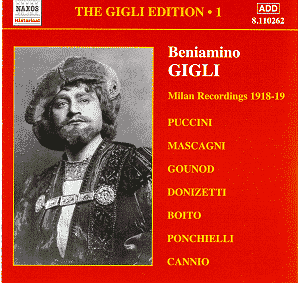As I played this CD the years rolled back. I remembered hearing and seeing this great singer at one of his farewell concerts (only Sinatra did more farewells) at Kings Hall in Manchester in the early 1950s. A small man, he rested his right hand on the piano and poured out even golden tone. By then he had acquired a few bad vocal habits such as an excessive sob in ‘Che gelida manina’ and ‘Vesti la giubba’ but his ‘La donna e mobile’ was pure and ringing. In the inevitable encore he played with the phrases with a honeyed mezza voce that had the packed audience in raptures. The following weeks involved much sharpening of the thorn stylus, sorry … needle, and winding the handle, to play the four minutes or so of each 78 Gigli side in the family collection, including some found on this disc. The ‘Milan Recordings’ featured here were the first Gigli made after the conductor had brought him to the notice of Fred Gaisburg, legendary discoverer and recordist of Caruso.
From very early on in his career Gigli’s lyric tenor had potential heft for the heavier roles although he never had the weight of tone to be a truly spinto tenor. His future is clearly foretold in these first recordings where he is most comfortable in the extracts from the likes of Boito’s Mefistofele (trs.1, 4, 5 and 11), Ponchielli’s La Gioconda (trs.7, 12 and 14) and Gounod’s Faust (trs.15-17), sung in Italian as are all the excerpts. These essentially lyric tenor roles and Gigli’s even vocal emission, from chest through the passaggio into the head voice, is even and long-breathed, with the voice perfectly supported and the diction clear. By comparison his rendition of Cavaradossi’s ‘Rencondita armonia’ from Tosca (tr.2), a heavier role, is not as sweet although Gigli had his first stage experience of the role in 1915. Similar comment could be made of the extract from Mascagni’s Iris (tr.10), while in the composer’s Lodoletta (tr.9) there is evidence of those sobs that he over-used in later years and which so offended purists. The sequence of items on the disc is according to date of recording (all provided) and not grouped by composer or work. All the duet partners are of more than adequate standard.
The audio restoration by Mark Obert-Thorn gives more silent surfaces than I got from my thorn needles those years ago. I cannot pretend my mind’s ear can draw comparison with those 78s, or the live performance, over the time-scale. Suffice it to say that this issue is in good clear sound and represents the earliest recordings of one of the 20th century’s greatest singers who incidentally died, in 1957 not, as the leaflet states, 1975. This disc costs little more than a packet of cigarettes. Buying the 78s involved in the 1950s, when they had been in circulation many years, would have cost the average working man several week’s wages; a salutary thought when we reflect on the current price of our enjoyments and indulgences.
Robert J Farr
